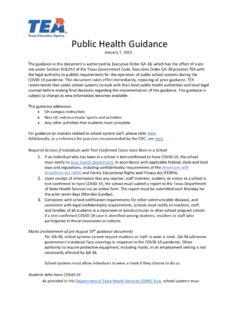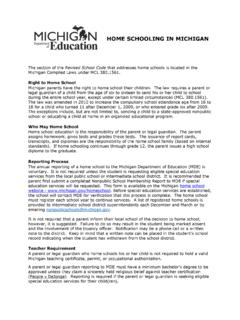Transcription of Intervention Strategies for Pre-School Students with ...
1 Forum on Public Policy 1 Intervention Strategies for Pre-School Students with Special Needs Gloria H. zucker , adjunct Professor, rutgers university Abstract Students with special needs require unique Intervention Strategies as they enter infant care and preschool environments. The techniques and materials discussed in this paper are designed especially for the child s unique abilities and disabilities. This paper will also focus on the skills needed for infants who have been identified as requiring Intervention Strategies as they transition into Pre-School and kindergarten programs. Strategies will be provided for parents who reinforce the skills and behaviors at home. Introduction Infant and preschool programs provide a unique experience for children as they begin the developmental journey to acquire the skills and subsets they need to succeed in kindergarten-twelfth grade.
2 In infancy the environment plays an important part of the learning scope and sequence providing both the stimulation and reinforcement needed to begin to gather information and knowledge. This paper will provide an introduction to the developmental stages from infancy through age four. For educators, the domains of knowledge will be introduced and defined. For parents, who reinforce these domains of knowledge in their homes, the specific skills and techniques that are necessary will be discussed. Although the exact number of Students with special needs is unknown, Study after study shows that intense preschool services produce huge academic, social and economic benefits- including savings to society of $30,000 to $100,000 per child .1 But cost is often not a factor to those families with preschoolers who are developmentally disabled.
3 Developmental Stages Infants between one and six months are developing the ability to interact with their environment. They are receptive to sounds, visual cues, and tactile interaction with other humans. Motorically they are beginning to have purposeful movement and focus on both sound and intonation. By the time babies are six months old they are clearly able to focus and differentiate objects that are ten to twelve inches away. Some, by this time, rock from side to side and some babies can even roll over. The social and emotional development is quickly being established with fear, surprise, pain, anger, and hunger indicated by different cries and facial movements. By the time they reach twelve months old crawling and creeping is evident and some children are walking by twelve months.
4 Socially and emotionally the fear of strangers is apparent as is the issue of abandonment. Often children of this age can be entertained for long periods of time by talking and moving in front of a mirror. At this age they laugh and interact with toys in a meaningful way. By twelve months many children are speaking their first intelligible words. 1 Margaret Dungle & Louis Vismara, MD, Developmental Checkups, EP Magazine(January 2004); 160 Forum on Public Policy 2 Between twelve months and twenty four months the sophistication of interaction is evident. Now the child can follow simple commands, tries to feed themselves, and repeats several words in sentences. It is expected that two year olds have approximately 200 words in their vocabulary.
5 It is at this time that the terrible two s emerge which can be accompanied by tantrums, resentment of change, and a new found independence in simple motor skills. As the child reaches three years old, motor ability increases as well as language skills improve considerably. Short three to seven word sentences are being formed and the child s sense of humor emerges. Emotionally, the fear of separation and the emergence of strong emotional reactions begin to surface. Sharing becomes an issue and oppositional behavior to parental demands can be evident. At this age the child parrots parental and sibling actions and verbal expressions. They are very comfortable with a standard routine, behavioral expectations, and clear consequences. At four years of age children are self-sufficient in many ways.
6 They enjoy helping out around the house and identifying themselves with the same sex parent. Dressing up for girls and playing sports for boys is typical and often rewarded by parents and siblings. Occasionally they become fearful of imagined monsters, scared of the dark, and awaken with bad dreams. Motorically their fine motor control is developed enough to draw circles and maybe even stick parts of the body. They can stand on one leg, ride a tricycle, and build fairly sophisticated block creations. Five years old is a transition point for many children. The expectations have been increased and achievements are measurable. Most children by this time have begun public schooling and have assumed a more formal learning posture. Play is now interactive and substantive.
7 The ability to play board games and sports has been established and the child derives pleasure from the interaction. Competitive play is evident and children tend to interact with the children in sex- appropriate activities. Domains of Early Childhood Learning There are four domains of early childhood learning that are considered privileged. This paper will discuss all four in detail with recommended instructional Strategies for each domain. Wright and Nueman (2009) in their article published by the Albert Shanker Institute state that the early childhood years are when very young children seek to build a base of understanding content and develop the skills in communication and language to share what they learn. They eagerly question the way things work And when provided with supportive and stimulating environments they eagerly engage in language learning, literacy practices, math play, and science exploration.
8 2 2 Tanya S. Wright, and Susan B. Nueman, Preschool Curriculum: What s in it for Children and Teachers? The Albert Shanker Institute. Washington, DC, (2009), Forum on Public Policy 3 Oral Language Kindergarteners are able to understand and repeat and average of 4000 words. They will also have the language skills to speak coherently three to five word sentences. In the pre-K years children concentrate on both receptive and expressive language. Some children acquire language rapidly and others struggle to process, store, retrieve, and then store the words again. The richer the environment is in vocabulary, the faster and more sophisticated the child becomes in this skill. The key areas of oral language that should be addressed in pre-K are vocabulary and phonological awareness.
9 Both relate to children s literacy development. Phonological awareness is the ability to hear and manipulate sounds in language. This understanding that the stream of oral language can be broken into smaller units of sound-words, syllables, individual sounds (phonemes) - enables children to map sounds onto letters when they begin formal instruction in reading. 3 As far as vocabulary, children with expanded word knowledge tend to relate to and understand more clearly and sophisticated, the books that are read to them and by them. These vocabulary skills serve children well throughout elementary and middle school as they are exposed to more complicated concepts, relationships, actions, and Children with limited oral language tend to have more academic issues and delays than Students with highly developed oral language skills.
10 Strategies for Oral Language Instruction Adults and siblings should regularly engage the young child in talking about anything and everything. Conversation should be varied and constant with new and interesting topics brought up daily. It is critical for parents to chatter with their children about household topics to highly academic topics constantly. Young children are virtual parrots and tend to repeat adult conversations and intonations until they begin to process the information and take ownership of the ideas and vocabulary. Both parents and teachers should encourage language rich classrooms as shared by Wright & Nueman. They should: Engage children in extended conversations Encourage children to tell and retell stories and describe events. Discuss a wide range of topics.















